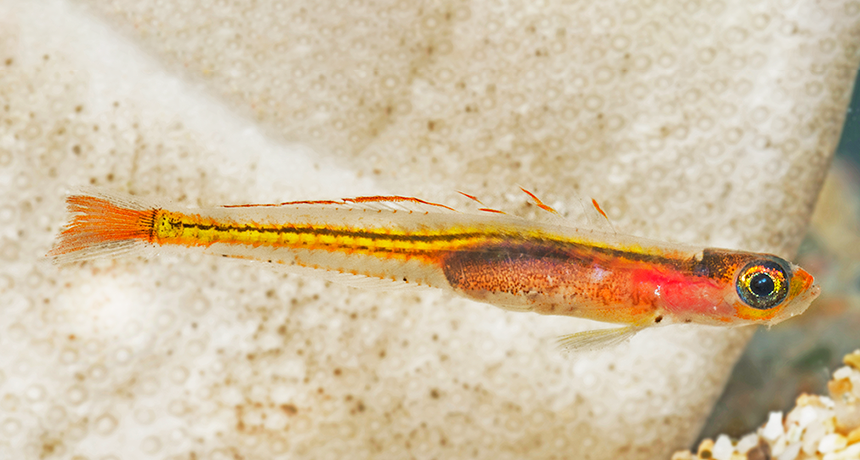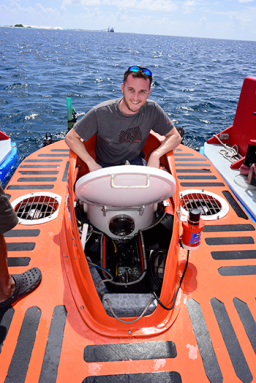Camera catches new fish species — as it’s eaten!
Invasive lionfish appear to threaten deep-reef species

This newly discovered ember goby lives on deep coral reefs in the Caribbean Sea. It travels in schools by the hundreds. But a voracious invader there likes to gobble them up.
Barry Brown
Hundreds of feet below the surface of the Caribbean Sea, a lionfish stalks its prey. It splays colorful fins, darts forward — then gulp! A tiny, brightly colored fish disappears into the predator’s stomach. Scientists in a nearby submarine caught this deep-sea drama on film. Then they realized something disturbing. The lionfish’s snack had been a brand-new, unnamed species.
“The coloration on [the prey] was so dramatic and so brilliant. It had this big bright orange-yellow stripe down the side and these huge eyes,” recalls Luke Tornabene. He works at the University of Washington’s School of Aquatic and Fishery Sciences in Seattle. A biologist, he studies the diversity of deep coral reefs. And he has just helped describe and name the new lionfish-prey species. It’s now called Palatogobius incendius (Pah-LAT-oh-GO-bee-us In-SEN-dee-us) — or the ember goby.

Deep reefs are full of undiscovered creatures. “Every trip to a new location,” Tornabene says, “we find three or four new species.” Unfortunately, in the Caribbean, his team also has been spying a lot of lionfish.
That large, showy fish is not native to the Caribbean or to the Atlantic Ocean. Yet it thrives in each, chowing down on native species. Most attempts to reduce lionfish numbers rely on human divers. But this fish has been feeding and breeding at great depths — up to 122 meters (400 feet). Most divers can’t descend more than 40 meters. So their efforts have focused on getting lionfish that patrol shallow water.
Tornabene felt troubled when he first saw the invasive fish in the deep reefs. He realized it could be eating species we don’t even know about yet. That video “confirmed our deepest fears,” he now says. His team described the new goby and its lionfish threat May 25 in PLOS ONE.
In the Caribbean, the lionfish already threatens 21 known fish species with extinction. This comes out of a recent report from the International Union for Conservation of Nature (IUCN). Most of these threatened fish, including other types of gobies, live on shallow reefs. But no one knows whether or how many deep-reef denizens might also be endangered. Researchers simply don’t have enough information about them.
Stephanie Green is a marine ecologist at Stanford University in California. She was not involved in the ember goby discovery. But the video “shows how much work we have to do in these deep places,” she says. Lionfish could hunt species to extinction before they are even discovered. Then scientists would never know they ever existed.
Thankfully, the ember goby population seems plentiful. But many species remain undiscovered. And the clock is ticking. Argues Green: It’s urgent that researchers document deep reefs before lionfish alter them entirely.







